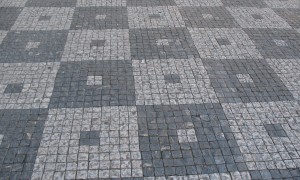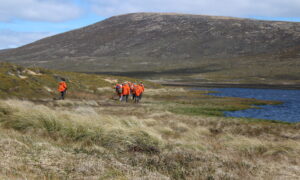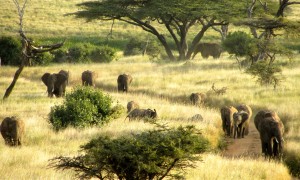
I pondered for weeks over how to best present the immensity of my latest adventure when it (far) exceeds easy expression. For starters, there are more than 6,000 images from my cameras to sift through in a frustrating efforts to pick the best ones. After 20 days steaming on a ship from the Falklands to South Georgia Island to the Antarctic Peninsula and back up the Drake Passage, the story feels big because it is big. The only possible way is to recount it in multiple smaller bite-sized pieces. But first, let me offer up this overview blog as a preface to others to come. Have a seat, grab your atlas, and come along on an epic ride.
Luckily, we enjoyed excellent weather overall, and remarkable people among both the crew and passengers. We met up in Santiago, Chile, then flew three-plus hours across the southern tip of South America to the Falkland Islands, famous internationally for its 1982 conflict with Argentina. The many islands constituting the Falklands are largely stark, low-lying, and windswept, shared by humans and their domestic sheep and cows with nesting colonies of rockhopper and gentoo penguins, several species of albatross, and a huge Imperial shag (cormorant) colony of about 90,000! Visits to several beaches and wildlife areas over the course of two days proved dismaying to some, given that the “diddle-dee” (a low-lying, dense shrub) made for difficult walking despite the relatively level terrain!



Steaming the 770 miles to South Georgia Island took two-plus sea days. We knew we were within 150 miles when the Shag Rocks appeared from the mist. These six isolated, weather-beaten rock islands, just 49 acres in size, were crowded with Imperial shag colonies. At some point in those couple of days, we crossed the Antarctic Convergence, in which the water temperature drops about five degrees quite abruptly (over the course of about 30-60 nautical miles). This phenomenon occurs because the sea water currents that encircle the Antarctic Continent (at about 34 degrees F.) encounter the warmer Sub-Antarctic surface water (about 41 degrees F.). These bodies of water just don’t mix much. “The colder and denser Antarctic surface waters slides below the less-dense Sub-Antarctic water,” according to our shipboard information, causing a profound upwelling of rich food resources rising from the deep. At the convergence, air temp falls, fog is increasingly likely — and wildlife populations explode, thanks to all that food.


For five days, we were treated to beaches teeming with wildlife: the birds! the seals! It was a riot of sound and movement. Beachmaster elephant seals were surrounded by their harems. These two ton behemoths were hard at work both re-inseminating their females (on the heels of weaning the current year’s crop of pups) and holding upstart bulls at bay – often with astonishing vigor! Fur seals took positions up in the tussocks of the hillsides. Penguins brayed, seal pups bleated. Opportunistic skuas feasted on the dead. Penguin feathers littered the ground like confetti from the widespread fledging that was going on. It was impressive, and scary sometimes, and a lot of fun. We hiked, visited whaling stations and the South Georgia Historical Trust’s museum and the local church in Grytvikken.



Throughout, it was easy to agree with whoever said that the terrain of South Georgia is as if someone sliced off the heights of the European Alps and transplanted them to this southern ocean. Stunning, and a huge contrast with the Falklands.

Another two days of steaming led us past the South Orkney Islands to 65 degrees south along the eastern side of the Antarctic Peninsula, into the Weddell Sea! It was unimaginable that we could go there, but we did, thanks to our intrepid expedition leader, Russ Evans (born and raised in the Falklands) and our fabulous Captain Oliver Krauss on the National Geographic Explorer. Our six days in Antarctica also included cresting the peninsula to steam down the west side. We reached Port Lockroy with five pallets to deliver to the museum there. In coming blogs, you will hear about the world’s largest iceberg, among (the many) other things we saw and did. Stay tuned!


[Our hosts were the cream of the crop at National Geographic and Lindblad Expeditions. See more at https://www.nationalgeographic.com/expeditions/]
Kate Dernocoeur considers Planet Earth to be her home, and likes to visit its many different places. This sometimes takes her away from her residence in Vergennes Twp, Michigan, where she enjoys living with her German shepherd dog, Mayzie. When home, she can be found writing or doing any of a number of other jobs (although she did retire reluctantly from firefighting in Jan.2019), or enjoying her passion for horses. See more at www.katedernocoeur.com








Comments
1 CommentJudy Bereza
Feb 18, 2020Kate, this is fascinating! Looking forward to more installments!